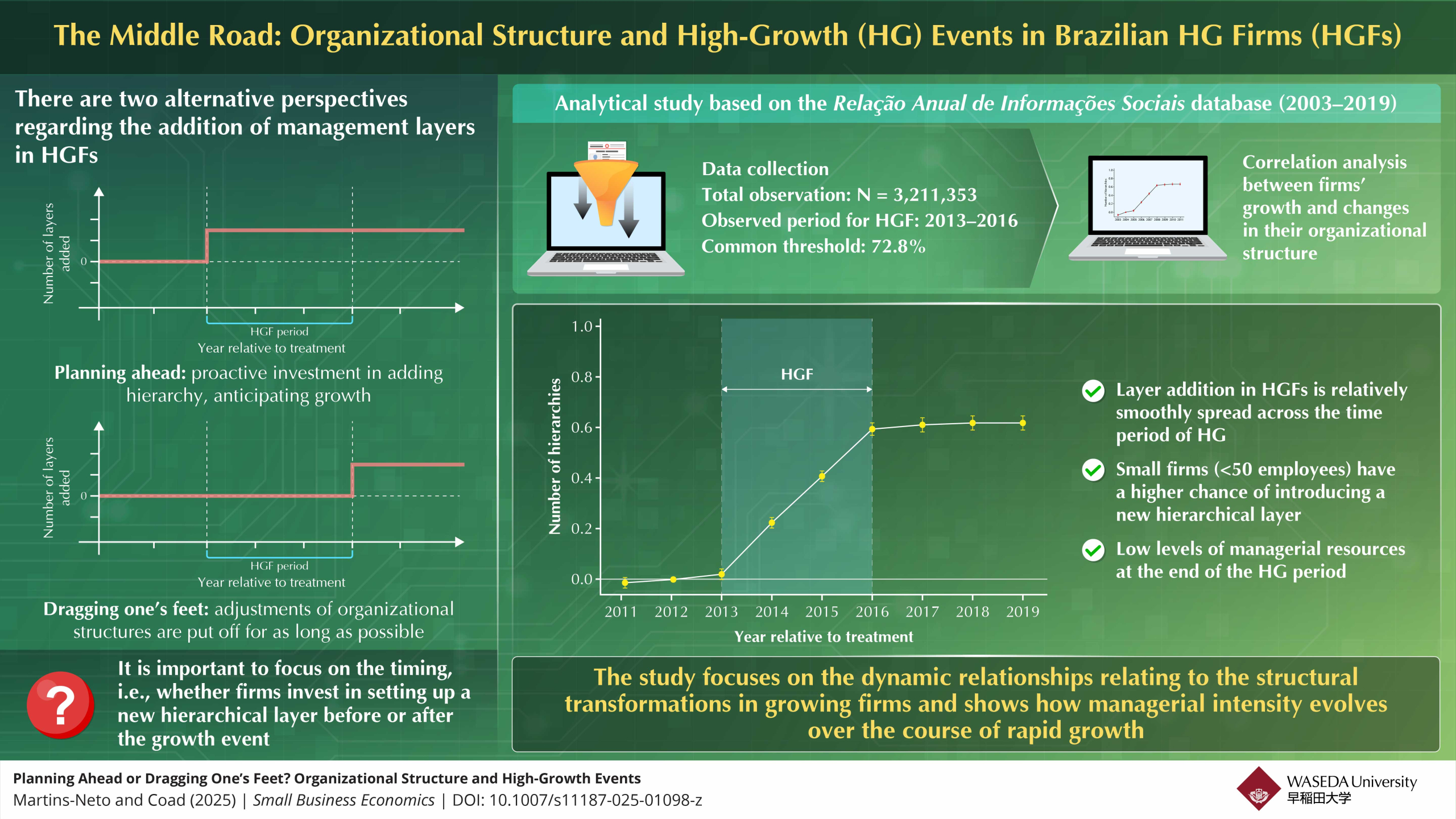Hiring in High-Growth Firms: New Study Explores the Timing of Organizational Changes
Tue, Oct 7, 2025-
Tags
Hiring in High-Growth Firms: New Study Explores the Timing of Organizational Changes
Researchers investigate how introduction of a new hierarchical layer in high-growth firms is connected with the timing of high-growth period
Entrepreneurship studies often focus on firm growth-related topics. The factors affecting the high-growth (HG) in high-growth firms (HGFs) are not well established. While some studies suggest that proactive strategizing precedes the HG period, others consider that the near-random structure of the firm’s growth is better to delay growth-related investments. This study focuses on the “timing” of setting up new hierarchical layers and the consequences if it happens before or after the growth event.

Image title: Hiring During High-Growth Events? Understanding the Timing to Add New Hierarchical Layer in High-Growth Firms
Image caption: Researchers try to understand the timing of the introduction of a hierarchical layer in a high-growth organization. The result sits in-between the two established theories, one highlighting the pre-planning method, while the other states that the organizational change happens only when it is unavoidable.
Image credit: Professor Alex Coad from Waseda University, Japan
License type: Original content
Usage restrictions: Cannot be reused without permission
High-growth firms (HGFs) refer to businesses that achieve rapid growth in terms of employees or revenue. Based on the established definition, HGFs are businesses with at least 10 employees and annual growth rates of 20% or more, observed over a period of three years. This three-year span is considered the high-growth (HG) period of the company. Even though this growth is often short-lived and difficult to sustain, it plays a significant role in driving economic dynamism. Hence, entrepreneurship-related research often focuses on the growth pattern of the HGFs and factors that affect the growth.
One such factor that affects the growth is the introduction of hierarchical layers. To shed light on the role of introducing hierarchical layers into HGFs, Professor Alex Coad from Waseda Business School, Waseda University, Japan, along with Dr. Antonio Martins-Neto, from the World Bank, Washington, D.C., USA, conducted a study based on the Brazilian employer–employee census micro-data for the period of 2003–2019. An article describing their research was published online in the journal Small Business Economics on September 11, 2025.
“There are two competing theories regarding the companies’ plans for the organizational infrastructure,” explains Prof. Coad. One theory talks about planning ahead, which highlights how firms plan ahead and invest proactively before the HG period. According to this theory, the companies invest in adding management layers in anticipation of growth. The other theory is called “dragging one’s feet.” This refers to the situation where firms put off adjusting their organizational structures for as long as possible. In these cases, the addition of a hierarchical layer often happens at the end of the HG period.
The researchers conducted a study which is entirely based on the Relação Anual de Informações Sociais (RAIS) database from 2003 to 2019. This comprehensive database is managed by the Brazilian Ministry of Labor and Employment and includes information on over 40 million individuals annually. The analysis was done based on 3,211,353 observations, and 2013 to 2016 was considered as the HG period (in the baseline analysis). The study followed the previously established classification of workers that included chief executive officers and managers, professionals, technicians, clerks and services, and production workers. Applying the difference-in-difference technique, the conditional correlations between firms’ growth and changes in their organizational structure were established based on the database to investigate the perfect “timing” for organizational restructuring.
“The findings of our study were interesting,” states Prof. Coad. “The results neither fit closely to the ‘planning ahead’ scenario, nor did they fit the ‘dragging one’s feet’ theory.” The addition of the new hierarchical layer occurred neither at the start nor at the end. However, as the firms started to expand, the HGFs started to add new knowledge hierarchies until the point at which they ceased to grow. This change happens smoothly and uniformly.
A notable distinction in hiring patterns was also observed between bigger and smaller firms. Smaller firms, with fewer than 50 employees, tend to add layers soon after growth begins, highlighting the influence of size on organizational decisions. As the firms grow in size, the share of managers decreases, suggesting that firms have low levels of managerial resources at the end of an HG period. The number again goes up later on.
“Planning ahead too much can be a risky strategy. But then again, delaying as much as possible also has drawbacks. It is better to take the middle road,” explains Prof. Coad, while talking about the implication of the study. The study can give the policymakers a direction regarding supporting the firms during their growth phase, instead of seeking a proactive role. This might lead to further growth and development of the HGFs in the near future.
Reference
Authors: Antonio Martins-Neto1, Alex Coad2
Title of original paper: Planning ahead or dragging one’s feet? Organizational structure and high-growth events
Journal: Small Business Economics
DOI:10.1007/s11187-025-01098-z
Affiliations:1World Bank, Washington, D.C., USA, 2Waseda Business School, Waseda University, Shinjuku, Japan
About Professor Alex Coad from Waseda Business School
Alex Coad is a Professor at Waseda Business School in Tokyo, Japan, who specializes in business performance, entrepreneurship, strategy, and innovation policy. He earned a joint Ph.D. from Université Paris 1 Panthéon-Sorbonne and the Sant’Anna School in Pisa, Italy. Previously, he held academic positions at the Max Planck Institute, Aalborg University, and SPRU. He has more than 100 publications in international peer-reviewed journals, including Research Policy, Journal of Business Venturing, and Economica. He is associated as an Editor with the journals “Research Policy” and “Small Business Economics.” In 2016, he received the Nelson Prize at the University of California, Berkeley.














